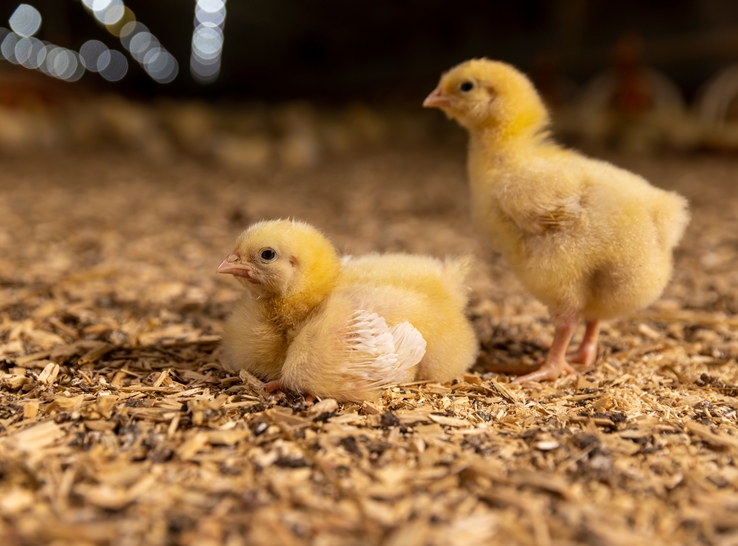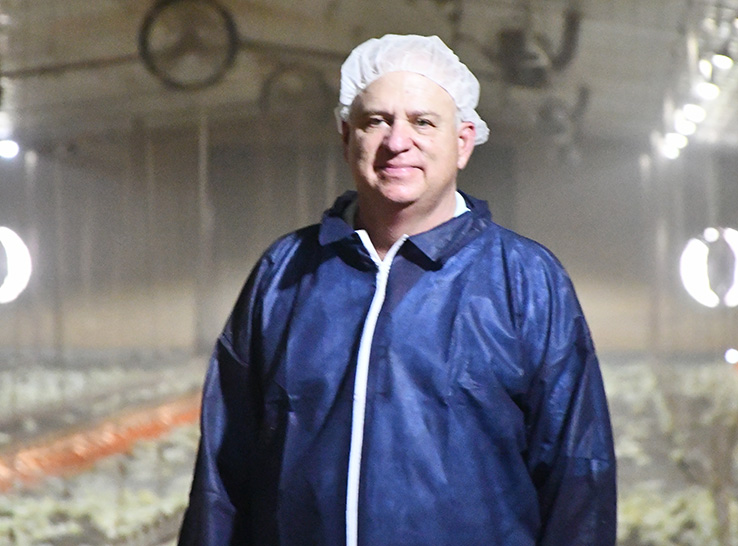What are the top priorities when it comes to poultry management? Brian Fairchild, PhD, professor and Extension poultry specialist at the University of Georgia, discussed his top seven considerations for effective poultry management during a recent Poultry Science Association webinar.
“All poultry producers would enjoy starting with exceptional chicks; however, maintaining ideal environmental conditions can help the performance of chicks with poor quality,” Fairchild said.
While good-performing flocks typically have good 7-day chick weights, he noted that getting chicks off to a good start is more about development than weight gain. A good start hinges on effective management practices that consider:
- feed
- water
- temperature
- relative humidity
- air quality
- light
- disease protection
A primary goal of poultry management is to minimize bird stress by providing the resources that birds need.
Feed and water
When it comes to feeding, Fairchild emphasized the importance of proper feed formulations to meet the birds’ nutritional needs, as well as managing the feeders. He noted that feeder location and ease of access — without allowing birds to rest in feeders — go a long way in ensuring that birds are eating well.
“Feed and water consumption are directly correlated,” Fairchild pointed out. Water availability is important, and considerations in drinker management, such as height and water pressure, should be managed according to the drinker manufacturer’s guidelines. Otherwise, birds may not get the volume of water needed, or the litter quality may deteriorate faster.
To ensure water is available to chicks, Fairchild stated that typical drinker management involves line height set, where the trigger pins are at the chick’s eye level. This encourages chicks to peck at the shiny pin, learning how to access water.
“Low lines lead to wet floors, and lines that are too high restrict water to birds and may limit feed consumption,” he cautioned.
After 4 or 5 days, the lines can be raised so that chicks are drinking at a 70-degree angle. Water pressure levels need to provide a consistent drip-drip-drip, but Fairchild didn’t provide an exact number, instead suggesting that producers adhere to the manufacturer’s recommendations. “Monitoring litter conditions under the drinkers is another method of determining if drinker height and pressure are adequate,” he added.
“In a perfect world, it would be nice to provide the birds the absolute highest quality of water we could, but birds don’t need the same water as we do,” Fairchild said. However, “water quality is often overlooked.” For example, hard water with high mineral content and water with low pH can lead to water line problems. In addition, water quality issues can cause scale buildup, clogged pins and lines, wet floors and increased bacteria exposure.
Fairchild suggested water lines be cleaned, flushed and checked between flocks to reduce contamination and maintenance issues. He also noted that the lines should be flushed each time a product is given to the birds through the drinking water.
Temperature
The temperature in poultry houses profoundly impacts health and feed consumption. A uniform temperature throughout the house is especially important for research studies and newly hatched chicks, which can’t regulate their body temperature. The mixing of air from floor to ceiling, accomplished with circulation fans, is crucial for maintaining a uniform temperature.
Fairchild suggested a floor temperature of 90 – 95°F for chicks. He stated that effective temperature (what it feels like to the birds) is the result of several contributing factors, including:
- feed consumption
- air and floor temperature in the house
- humidity
- bird density
For commercial houses, Fairchild supports the use of radiant heat. “Properly designed radiant heat systems do a good job of heating the floor efficiently and allow the birds to find their comfort zone.”
Warmer temperatures near the heat source and cooler temperatures farther away enable older chicks to gravitate toward warmer areas when they are cold and move to cooler areas if they are hot. Rectal thermometers can be used to monitor the temperature of birds, but Fairchild said the depth to which the probe is inserted affects the reading. He also noted that individual birds, like people, prefer different environmental temperatures.
Fairchild said the best indicators of correct house temperature are the birds themselves.
“Entering a house, I watch the birds, observing their behavior and distribution. Ideally, one-third of the birds will be eating, another third resting and the last third drinking. We want to see the birds spread out evenly and acting normally. This lets you know they are comfortable.”
Relative humidity
The relative humidity within the house impacts birds’ comfort and health. Fairchild prefers a humidity level between 40% and 60%. He pointed out that dust is more prevalent in houses with less than 40% humidity, while high humidity can exacerbate respiratory issues.
Fairchild doesn’t see oxygen level concerns in houses; however, he does see problems with ammonia, and occasionally carbon dioxide and carbon monoxide. Wet houses and high humidity lead to more ammonia build-up and respiratory complications. Carbon dioxide levels need to be less than 5,000 ppm, he said, because higher levels cause increased heart size and have been suggested to contribute to pulmonary hypertension. And he said the research indicates that carbon monoxide levels should be below 50 ppm.
“Poorly maintained heaters, evident by soot buildup, are typically a good indicator that a heater is producing increased carbon monoxide levels,” Fairchild stated. “Carbon monoxide is not a ventilation issue but a maintenance issue.” Heaters that are not maintained well will not burn gas efficiently, producing carbon monoxide as a result, he explained.
Thankfully, the ammonia, carbon dioxide and relative humidity can be remedied by simply adjusting the ventilation fans.
Lighting
Lighting also impacts birds’ activity, health and feed consumption.
Fairchild reported that he sees increased activity and feeding when lights first come on and a decrease in activity close to lights out. At placement, providing a brighter, uniform light increases bird activity and helps them locate resources.
While the trend has been to provide near-continuous light for the first week, he commented that recent research supports providing 4 to 6 hours of darkness at placement. After young birds have acclimated to their surroundings, typically around 5 days after placement, the lighting intensity can be decreased, depending on the company’s management protocols.
Disease protection
Fairchild’s final piece of advice for effective poultry management was to ensure birds are protected against disease. He noted that chicks from hatcheries often have had vaccinations, but utilizing vaccines is just the start of disease protection.
Confined housing and biosecurity protocols, including handling birds with gloves and using foot baths, limit the birds’ exposure to potential pathogens. However, Fairchild pointed out that sound immune systems are a key part of getting the best protection against disease.
Getting good-performing and healthy birds
How do you know if you have things right in each poultry house? Fairchild recommends using current technology that can provide actual numbers for temperature, humidity, air quality, light intensity and water consumption. But he cautioned producers not to rely solely on numbers and technology, and to remember that observing bird behavior will provide clues on how well the birds are doing and point toward potential problems.
Continual access to the best feed, water, optimal environmental conditions, and protocols that promote effective management practices leads to thriving, happy and healthy birds.








